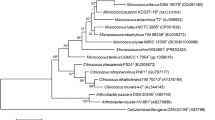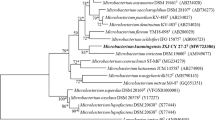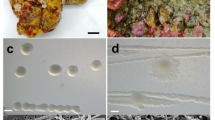Abstract
A novel actinobacterium, designated strain JXJ CY 01T, was isolated from a mucilaginous sheath of Microcystis aeruginosa FACHB-905 collected from Lake Dianchi, south-west China. Taxonomic position of the isolate was determined by polyphasic approaches. Strain JXJ CY 01T shared 16S rRNA sequence similarities of 98.9 and 98.0% with Microbacterium marinilacus YM11-607T and Microbacterium paludicola US15T, and less than 98% with other members of the genus Microbacterium. The DNA–DNA relatedness values between strains JXJ CY 01T and M. marinilacus JCM 16546T and M. paludicola JCM 14308T were 53.5±1.4 and 53.8±2.1%, respectively. l-Ornithine was detected in the cell wall, and rhamnose, galactose, glucose, arabinose, fucose and mannose as signature sugars in the whole-cell hydrolysates. Other chemotaxonomic characteristics determined were MK-12 and MK-11 as predominant menaquinones, anteiso-C15:0, iso-C16:0, anteiso-C17:0 and iso-C17:0 as major cellular fatty acids (>10%), and diphosphatidylglycerol, phosphatidylglycerol, an unidentified glycolipid and two unidentified phospholipids as the polar lipids. The DNA G+C content was 70.4 mol%. On the basis of the above taxonomic data, strain JXJ CY 01T is determined to represent a novel species of the genus Microbacterium, for which the name Microbacterium lacusdiani sp. nov. is proposed. The type strain is JXJ CY 01T (= KCTC 29655T=DSM 29188T). The type strain JXJ CY 01T can solubilize both insoluble inorganic (calcium phosphate) and organic phosphate (l-α-phosphatidylcholine) and is possibly one of the mechanism for enhancement of growth of M. aeruginosa FACHB-905.
Similar content being viewed by others
Log in or create a free account to read this content
Gain free access to this article, as well as selected content from this journal and more on nature.com
or
References
Pan, G., Zhang, M. M., Chen, H., Zou, H. & Yan, H. Removal of cyanobacterial blooms in Taihu Lake using local soils. I. Equilibrium and kinetic screening on the flocculation of Microcystis aeruginosa using commercially available clays and minerals. Environ. Pollut. 141, 195–200 (2006).
Liu, Y. M. et al. Analysis of paralytic shellfish toxins in Aphanizomenon DC-1 from Lake Dianchi, China. Environ. Toxicol. 21, 289–295 (2006).
Liu, L. P. Characteristics of blue algal bloom in Dianchi Lake and analysis on its cause. Res. Environ. Sci. 12, 36–37 (1999).
Dziallas, C. & Grossart, H. P. Temperature and biotic factors influence bacterial communities associated with the cyanobacterium Microcystis sp. Environ. Microbiol. 13, 1632–1641 (2011).
Parveen, B. et al. Bacterial communities associated with Microcystis colonies differ from free-living communities living in the same ecosystem. Environ. Microbiol. Rep. 5, 716–724 (2013).
Shi, L. M., Cai, Y. F., Kong, F. X. & Yu, Y. Specific association between bacteria and buoyant Microcystis colonies compared with other bulk bacterial communities in the eutrophic Lake Taihu, China. Environ. Microbiol. Rep. 4, 669–678 (2012).
Casamatta, D. & Wickstrom, C. Sensitivity of two distinct bacterioplankton communities to exudates from the cyanobacterium Microcystis aeruginosa. Microb. Ecol. 41, 64–73 (2000).
Deng, J. et al. Effect of attached bacteria of carbonic anhydrase on the growth of Microcystis aeruginosa. J. Lake Sci 24, 429–435 (2012).
Jürgens, K. & Güde, H. The potential importance of grazing-resistant bacteria in planktonic systems. Mar. Ecol. Prog. Ser. 112, 169–188 (1994).
Niu, Y. et al. Phytoplankton community succession shaping bacterioplankton community composition in Lake Taihu, China. Water Res. 45, 4169–4182 (2011).
Shi, L. M. et al. Phylogenetic diversity and specificity of bacteria associated with Microcystis aeruginosa and other cyanobacteria. J. Environ. Sci. 21, 1581–1590 (2009).
Yang, L. Y. & Xiao, L. Outbrust, Jeopardize and Control of Cyanobacterial Bloom in Lakes 212 (Science Press, Beijing, (2010).
Zhang, B. H. et al. An antialgal compound produced by Streptomyces jiujiangensis JXJ 0074T. Appl. Microbiol. Biotechnol. 99, 7673–7683 (2015).
Shirling, E. B. & Gottlieb, D. Methods for characterization of Streptomyces species. Int. J. Syst. Bacteriol. 16, 313–340 (1966).
Xu, P. et al. Naxibacter alkalitolerans gen. nov., sp. nov., a novel member of the family Oxalobacteraceae isolated from China. Int. J. Syst. Evol. Microbiol. 55, 1149–1153 (2005).
Kovacs, N. Identification of Pseudomonas pyocyanea by the oxidase reaction. Nature 178, 703–704 (1956).
Goodfellow, M. Numerical taxonomy of some nocardioform bacteria. J. Gen. Microbiol. 69, 33–80 (1971).
Williams, S. T. et al. Numerical classification of Streptomyces and related genera. J. Gen. Microbiol. 129, 1743–1813 (1983).
Hasegawa, T., Takizaea, M. & Tanida, S. A rapid analysis for chemical grouping aerobic actinomycetes. J. Gen. Appl. Microbiol 29, 319–322 (1983).
Tang, S. K. et al. Zhihengliuella alba sp. nov., and emended description of the genus Zhihengliuella. Int. J. Syst. Evol. Microbiol. 59, 2025–2032 (2009).
Minnikin, D. E., Collins, M. D. & Goodfellow, M. Fatty acid and polar lipid composition in the classification of Cellulomonas Oerskovia and related taxa. J. Appl. Bacteriol. 47, 87–95 (1979).
Collins, M. D. & Jones, D. Lipids in the classification and identification of coryneform bacteria containing peptidoglycan based on 2,4-diaminobutyric acid. J. Appl. Bacteriol. 48, 459–470 (1980).
Collins, M. D., Pirouz, T., Goodfellow, M. & Minnikin, D. E. Distribution of menaquinones in actinomycetes and corynebacteria. J. Gen. Microbiol. 100, 221–230 (1977).
Kroppenstedt, R. M. Separation of bacterial menaquinones by HPLC using reverse phase (RP18) and a silver loaded ion exchanger as stationary phases. J. Liq. Chromatogr. 5, 2359–2387 (1982).
Sasser, M. Identification of Bacteria by Gas Chromatography of Cellular Fatty Acids, MIDI Technical Note 101 (MIDI, Newark, DE, 2001).
Mesbah, M., Premachandran, U. & Whitman, W. B. Precise measurement of the G+C content of deoxyribonucleic acid by high-performance liquid chromatography. Int. J. Syst. Bacteriol. 39, 159–167 (1989).
Thompson, J. D., Gibson, T. J., Plewniak, F., Jeanmougin, F. & Higgins, D. G. The CLUSTAL X windows interface: flexible strategies for multiple sequence alignment aided by quality analysis tools. Nucleic Acids Res. 25, 4876–4882 (1997).
Saitou, N. & Nei, M. The neighbor-joining method: a new method for reconstructing phylogenetic trees. Mol. Biol. Evol. 4, 406–425 (1987).
Felsenstein, J. Evolutionary trees from DNA sequences: a maximum likelihood approach. J. Mol. Evol. 17, 368–376 (1981).
Fitch, W. M. Toward defining the course of evolution: minimum change for a specific tree topology. Syst. Zool. 20, 406–416 (1971).
Tamura, K. et al. MEGA5: Molecular evolutionary genetics analysis using maximum likelihood, evolutionary distance, and maximum parsimony methods. Mol. Biol. Evol. 28, 2731–2739 (2011).
Felsenstein, J. Confidence limits on phylogenies: an approach using the bootstrap. Evolution 39, 783–791 (1985).
Ezaki, T., Hashimoto, Y. & Yabuuchi, E. Fluorometric deoxyribonucleic acid-deoxyribonucleic acid hybridization in microdilution wells as an alternative to membrane filter hybridization in which radioisotopes are used to determine genetic relatedness among bacterial strains. Int. J. Syst. Bacteriol. 39, 224–229 (1989).
Wayne, L. G. et al. International Committee on Systematic Bacteriology. Report of the ad hoc committee on reconciliation of approaches to bacterial systematic. Int. J. Syst. Bacteriol. 37, 463–464 (1987).
Zhao, G. Y. et al. The importance of bacteria in promoting algal growth in eutrophic lakes with limited available phosphorus. Ecol. Eng. 42, 107–111 (2012).
de-Bashan, L. E., Antoun, H. & Bashan, Y. Involvement of indole-3-acetic-acid produced by the growth-promoting bacterium Azospirillum spp. in promoting growth of Chlorella vulgaris. J. Phycol. 44, 938–947 (2008).
Madhaiyan, M. et al. Microbacterium azadirachtae sp. nov., a plant growth-promoting actinobacterium isolated from the rhizoplane of neem seedlings. Int. J. Syst. Evol. Microbiol. 60, 1687–1692 (2010).
Acknowledgements
This research was supported by funds from Natural Science Foundation of China (No 31060010), Environmental Conservation Department of Jiangxi Province of China (No. JXHBKJ2013-14) and Program of Jiujiang University (No 201511). W-JL was also supported by Guangdong Province Higher Vocational Colleges & Schools Pearl River Scholar Funded Scheme (2014).
Author information
Authors and Affiliations
Corresponding author
Ethics declarations
Competing interests
The authors declare no conflict of interest.
Additional information
Supplementary Information accompanies the paper on The Journal of Antibiotics website
Supplementary information
Rights and permissions
About this article
Cite this article
Zhang, BH., Salam, N., Cheng, J. et al. Microbacterium lacusdiani sp. nov., a phosphate-solubilizing novel actinobacterium isolated from mucilaginous sheath of Microcystis. J Antibiot 70, 147–151 (2017). https://doi.org/10.1038/ja.2016.125
Received:
Revised:
Accepted:
Published:
Issue date:
DOI: https://doi.org/10.1038/ja.2016.125
This article is cited by
-
Genome mining and metabolite profiling illuminate the taxonomy status and the cytotoxic activity of a mangrove-derived Microbacterium alkaliflavum sp. nov
BMC Microbiology (2025)
-
Harnessing phosphate-solubilizing microorganisms for mitigation of nutritional and environmental stresses, and sustainable crop production
Planta (2025)
-
Microbes Mediated Nutrient Dynamics for Plant Growth Promotion: Current Research and Future Challenges
Indian Journal of Microbiology (2025)
-
Microbacterium rhizophilus sp. nov., an indole acetic acid-producing actinobacterium isolated from rhizosphere soil
Antonie van Leeuwenhoek (2025)
-
Micrococcus lacusdianchii sp. nov., an attached bacterium inhibited by metabolites from its symbiotic algae
The Journal of Antibiotics (2024)



